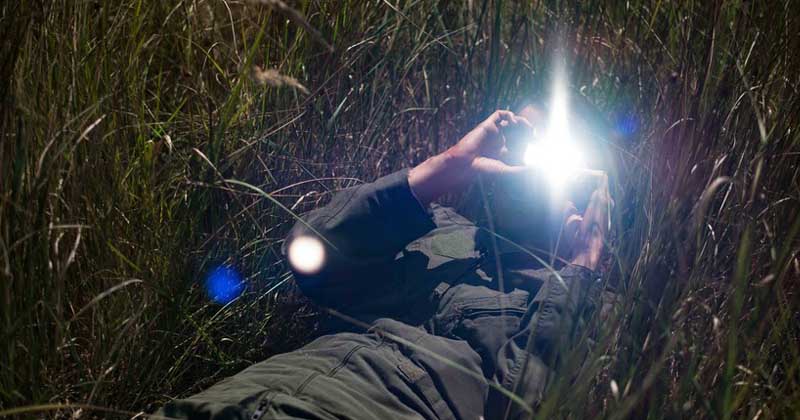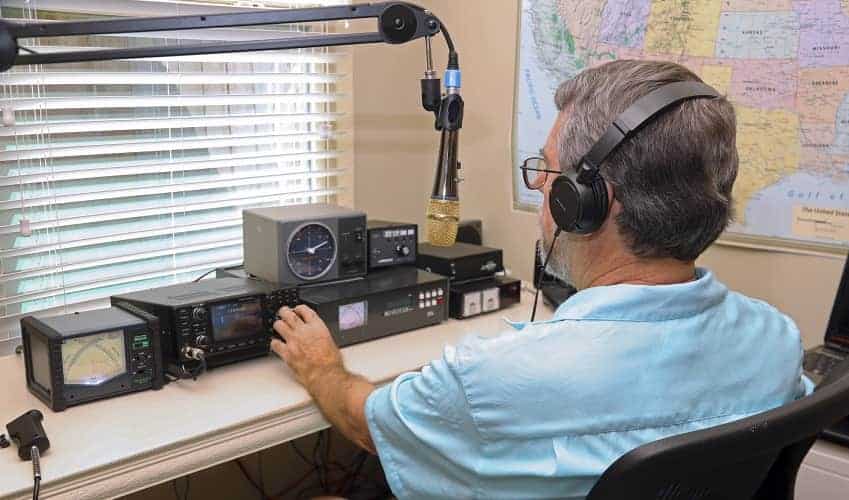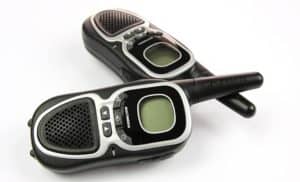You’re alone in the woods.
A storm’s brewing overhead.
Suddenly, a thunderclap announces its arrival.
As the hail hammers down, your cell phone gives up the ghost.
Now, you’ve got no way of telling anyone where you are – and no way to call for help.
What do you do?
If you make it back alive, the next time you venture out on a solitary mission, you’ll remember to take one of the following off-grid communication devices with you.
#1. Smoke And Mirrors: How To Use Old-Fashioned Signalling Techniques

Off-grid communication doesn’t have to be all smoke and mirrors, but it can help.
In the days before there was even a grid to get off, signal mirrors provided a vital lifeline for anyone living remotely, including early homesteaders and survivalists.
According to the US Airforce, a signal mirror is “probably the most underrated signaling device found in the survival kit.”
Indeed, like the UST StarFlash Micro Signal Mirror, a purpose-built signal mirror could be a lifesaver, especially if you know how to use it correctly. Light signals sent using one can be seen up to 50 miles away and don’t need any power, although using them at night won’t be very rewarding.
Make sure you’re not left out in the woods alone by investing in one of the best signal mirrors and learning how to use it effectively.
Also, see how to send a fire signal.
#2. Is A Satellite Phone Good For Emergencies?
Satellite phones have been around since the early Sixties, and satellite internet is expanding almost daily.
These days, satellite phones are smaller and more affordable than ever before. As long as they’re fully charged, they can operate effectively even without power and go where cellphones fear to tread.
Conversely, bad weather can disrupt the satellite signal, so if your emergency coincides with a hurricane, chances are you’ll be out in the rain without a signal.
So, while satellite internet solves the issue of how to get online access off-grid, as an emergency communication device, it’s unreliable.
#3. How To Use Ham Radio For Instant Communication

The Amateur Radio Service, more commonly known as Ham radio, is often the hero of the hour when it comes to catastrophes. It was used during 9/11 when the clogged cellphone network ground to a halt, and it saved the day when an earthquake hit Nepal in 2015.
Ham radio is often used in disaster situations because it operates well off the grid; transceivers can be powered by generators and set up just about anywhere. (source)
It’s also considered the best for emergency communications because it has the longest range and numerous channels to broadcast on.
Read our guide to the best ham radios for emergency preparedness.
#4. Is a Smartphone Smart Enough to Save You?
Even dedicated off-gridders like myself love their smartphones. They keep us connected, informed, and entertained.
While they offer a great way to stay connected off-grid, in many emergencies, the network is overloaded or down, leaving us with a lump of plastic that doesn’t even double up as a signal mirror.
Even if you’ve got the best hand crank phone charger to top up your battery when the power’s off, your cellphone won’t necessarily return the favor by picking up a signal.
As cell phones rely on ground-based towers, stormy weather can render them unworkable. Geographical features like hills and trees can also obstruct your signal, making them potentially useless in a survival scenario.
#5. Making a Mesh of Off-Grid Communications
A wireless mesh network is one way to convert your smartphone into an emergency communication device. Mesh technology is just emerging and promises an effective way of staying connected when off-grid and in emergencies.
For example, off-grid mesh communication devices, like the goTenna Mesh, can turn your cellphone into “a self-sufficient mesh network” that operates even when there’s no cellphone signal, and the power’s out. As it uses encrypted networks, it’s also completely private and secure.
Instead of relying on central points like cellphone towers, “mesh networks rely on users.” Each user’s node acts as another point of communication, and by using this peer-to-peer network, you’ll be able to communicate with other users several miles away. Although functionality is limited, you can send text messages and your GPS coordinates, which, in an emergency, is all you need.
Mesh communication devices theoretically work “absolutely anywhere on earth,” but there must be at least one other compatible mesh device within a 10-mile range.
As you buy the devices in pairs, you can be pretty confident you’ll be able to communicate with whoever has the other device, but beyond that, it could be frustratingly slow or simply impossible.
Furthermore, you can’t just send out a broadcast message in the hopes that it will find a nearby node to pass it on – you can only use nodes known to you. This is highly limiting, although goTenna is confident user numbers are increasing, with “deep-pocketed federal agencies and military branches… shelling out for the devices.”
Another drawback is that every hop the message takes to the next node halves the bandwidth, so if you’re miles away from civilization and your broadcast has to hop through a long chain of nodes, it would probably be easier to deliver the message by foot or carrier pigeon.
In the not-too-distant future, the goTenna Mesh device will come into its own, providing reliable off-grid communication via a powerful device that’s small enough to slip into your pocket.
Editors note: This is an update we received from Gotenna regarding stock levels:
Due to the overwhelming demand for our goTenna Mesh and the current global supply chain issues, the production of goTenna Mesh is delayed until 2023. We apologize for any inconvenience this may cause you, as this is out of our control.
2024 Update – still no progress on stock levels, not sure when or if this product will be available. If you know of any reliable alternatives, please let me know in the comments.
#6 Is The GPS Messenger a Beacon of Light?
GPS messengers and personal beacons are often lumped together, but they’re not the same thing.
PLBs don’t require a subscription as GPS messengers do but are limited in functionality; they can only send out a one-way, one-time emergency distress signal.
GPS messengers are more versatile and equally effective at calling for helping or getting your flatmate to put some beers in the fridge.
Oddly enough, however, PLBs cost much the same as a GPS messenger.
I was crewing on a horse trail along the Wild Coast in South Africa in November last year. This remote coastline is known for its dramatic geography and the inherent dangers that go with it. Cellphone coverage is patchy at best, so the trail guide decided to test out the capabilities of the latest GPS messenger – the Garmin inReach Mini GPS Satellite Communicator.
Using this device, we could, theoretically, track one another and send text messages directly from our cell phones without relying on the patchy network to transmit them.
Once the trail guide finally remembered to turn his on, the pair worked effectively enough, although the batteries drained quickly if we turned on the GPS tracking function.
Nevertheless, it was reassuring to know that we could contact one another if we encountered difficulty.
#7 Are Walkie-Talkies Reliable in an Emergency?

The walkie-talkie concept may seem outdated, but, like most other technology, it’s continually evolving.
An old-fashioned long-distance walkie-talkie, like the Midland – GXT1000, has a 36-mile range, will let you know if bad weather is heading your way, and allows for hands-free operation.
There are some excellent long-range walkie-talkies available, and if you pick a two-way radio, you’ll be to send a distress signal from virtually any location.
Conclusion
Even if you prefer a reclusive, solitary lifestyle, communicating in an emergency is crucial for your survival.
Whether it’s an end-of-the-world scenario or just the end of your tether causing the problem, you need to be able to reach out for help.
You can opt for a simple, non-technological solution like a signal mirror or take it to the other extreme and embrace the latest mesh technology.
If one of these off-grid communication methods has saved your bacon, please share your experiences in the comments below.



A long range walkie-talkie doesn’t really exist. Their ability to reach long distances depends on a lot of different factors, such as the terrain, tree density, man-made structures. If you are located in a flat location with nothing between you and the person you are trying to contact, you may get that 36-mile range.
What about a hand crank ham radio?